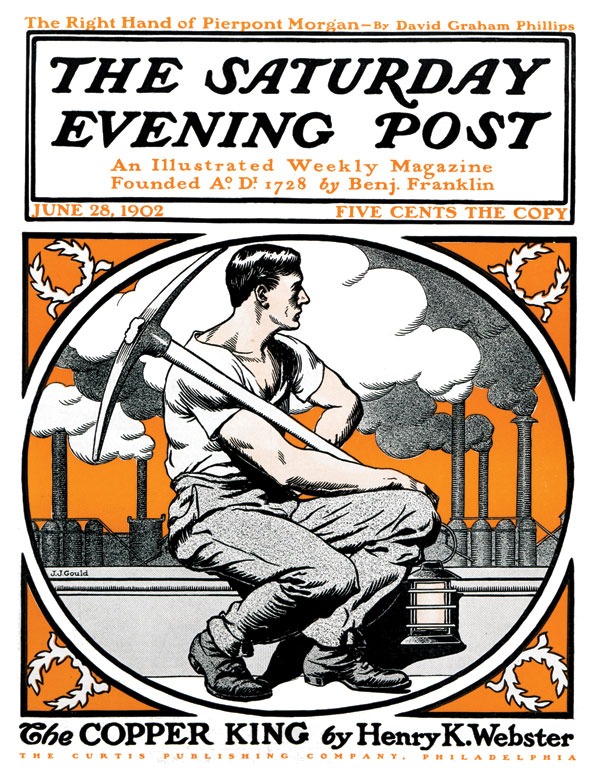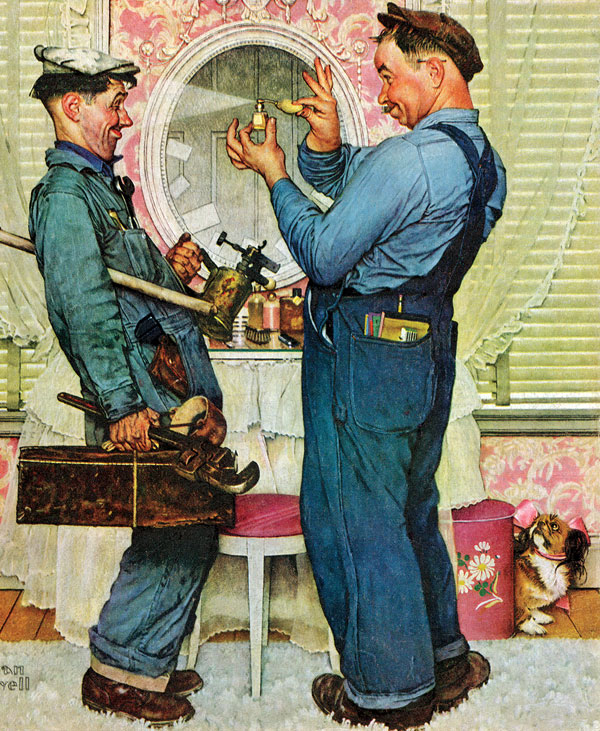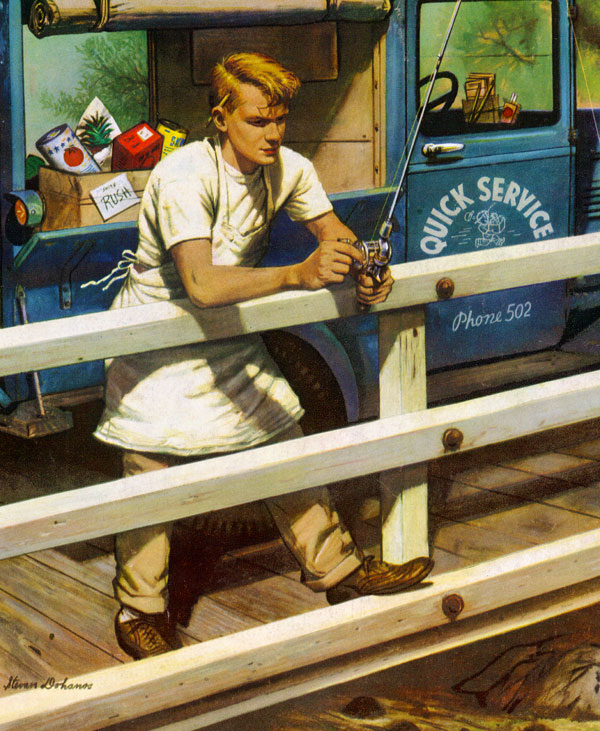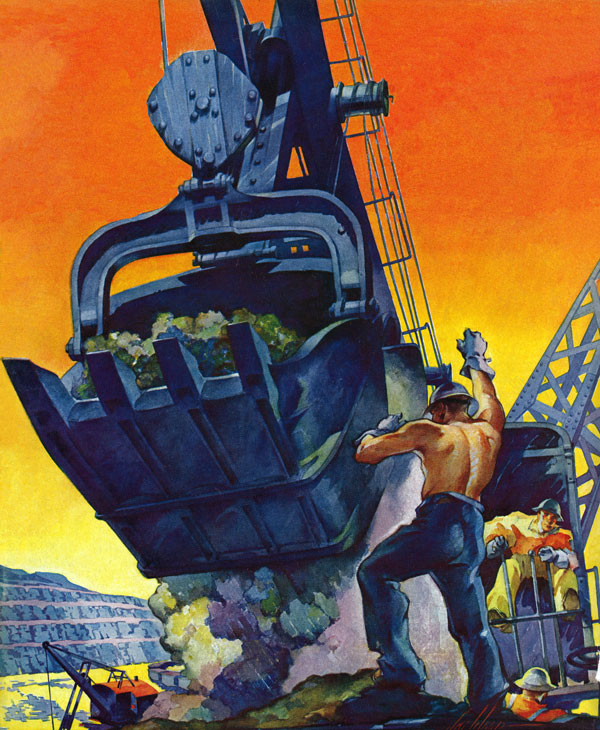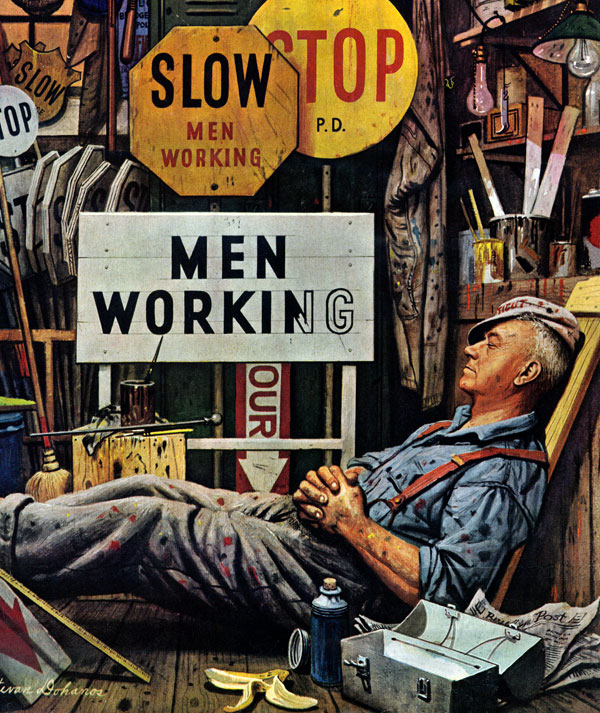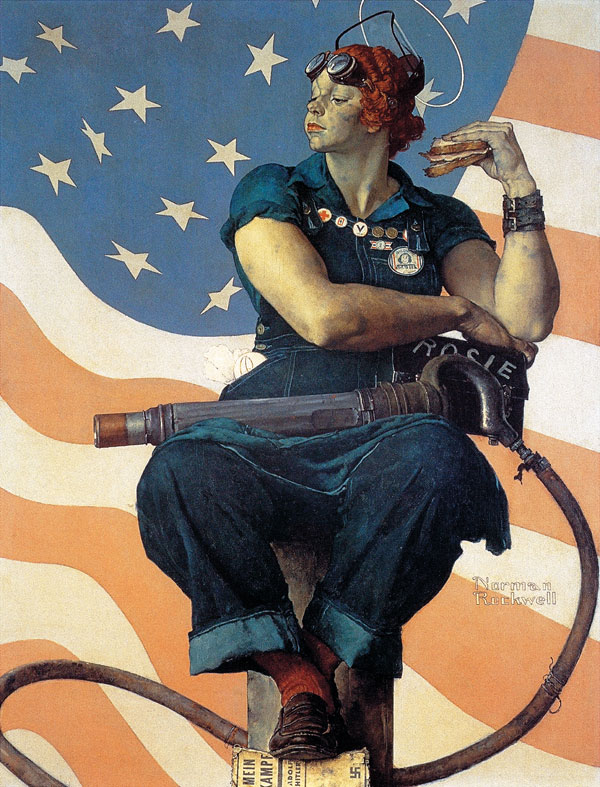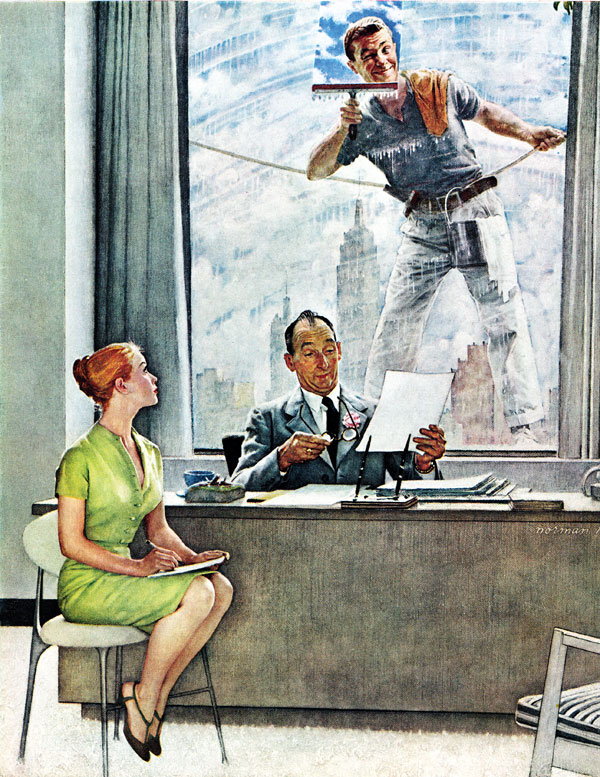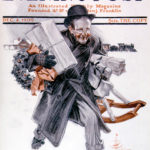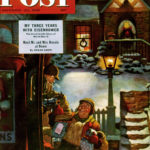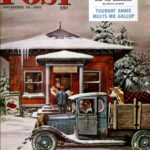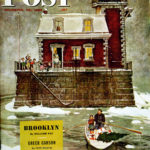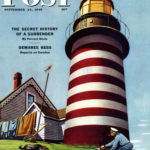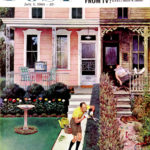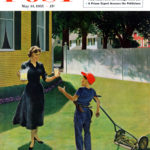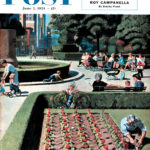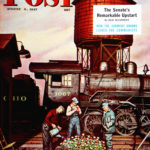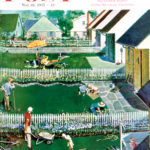Classic Covers: Lighthouses
Why are we so fascinated by lighthouses? Is it because they are so picturesque? Or because, if they could talk, what exciting and harrowing tales of the sea they could tell? Whatever the reason, two Post cover artists — Mead Schaeffer and Stevan Dohanos — loved them as much as the rest of us.
Lighthouses by Stevan Dohanos
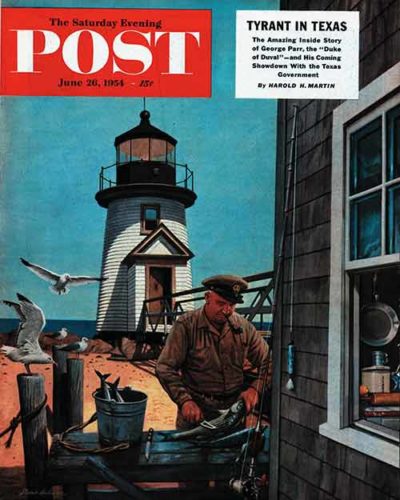
Lighthouse Keeper
by Stevan Dohanos
June 26, 1954
“Here a Coast Guard man,” Post editors wrote in 1954 of the cover above, “is adding to his duties the task of guarding coastal waters against getting too crowded with fish.” The ever-ravenous gulls await whatever tidbits they can make off with. The lighthouse was unidentified.
The candy striped tower (below) oversees a strait between the United States and Canada called Quoddy Narrows, looks much the same today as when Stevan Dohanos painted it in 1945.
The West Quoddy Light Keepers Association website fills us in on the intriguing history of this structure: The first tower, which was made of wood, “was built in 1808, by order of President Thomas Jefferson. The tower standing and operating today was built in 1857 and became operational in 1858.”
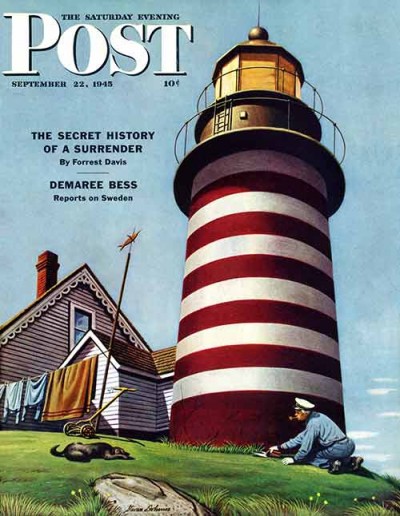
Lighthouse Keeper
by Stevan Dohanos
September 22, 1945
How did they illuminate the lighthouse in those days? The Light Keepers Association tells us it was “originally oil from sperm whales; to lard oil in the 1860s, to kerosene about 1880; to electricity in 1932.”
The artist took, well, artistic license, in painting this scene. Although the lighthouse was in Lubec, Maine, the lighthouse keeper trimming the grass was at Sankaty Light in Nantucket. Dohanos had made sketches of the striped West Quoddy lighthouse the year before, and because it was closer, went to the Sankaty Lighthouse to refresh his memory of the details. Turns out the Nantucket folks didn’t have much information on the Maine lighthouse. However, “they were cutting the grass at Sankaty Light,” editors noted, “and Dohanos liked that touch of domesticity or agriculture or whatever it is, so he included it.”
Mead Schaeffer’s Lighthouses
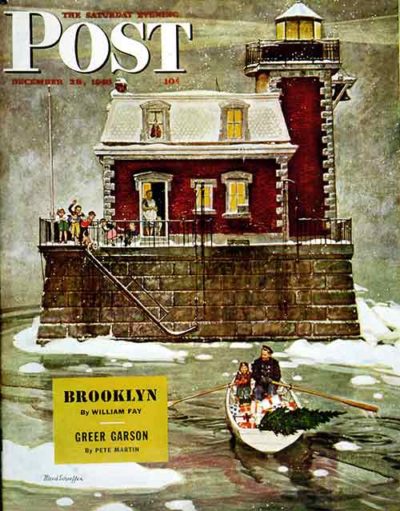
Christmas at the Lighthouse
Mead Schaeffer
December 28, 1946
Instead of resting on a strip of coastal land, this charming structure sits in the Hudson River between a town of the same name and Athens, on the other side. A large mud flat in the river stranded unsuspecting ships, so in 1873, construction began on the Hudson-Athens Lighthouse.

Today the lighthouse (at right) is an active aid to commercial ships and private boats in the Hudson River as it has been since 1874. (Photo courtesy of Hudson-Athens Lighthouse Preservation Society.)
The website for the Hudson-Athens Lighthouse Preservation Society includes floorplans and the history of the structure and its keepers. One of those, “Emil J. Brunner, kept the light from 1930 to 1949.” When Post cover artist Mead Schaeffer wanted to paint the scene, he asked Brunner and his family to pose.
“Artistic license allows for a dog (at the top of the steps),” writes Louise Bliss of the Preservation Society, “which was of course against Coast Guard rules, and there are too many children and there were no electric lights.” She’s right, the keeper and his wife had five children; the artist generously granted them eight. Intriguingly, Bliss noted, one of the little girls depicted, now grown of course, “comes to public tours in the summer and tells the tales of living on the lighthouse.”
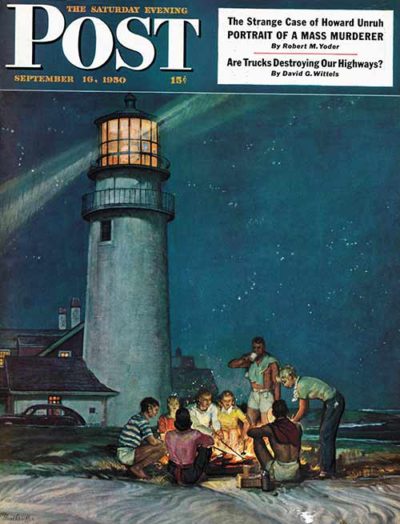
“Beach Bonfire”
by Mead Schaeffer
September 16, 1950
The cozy September scene (above) from 1950 is in Cape Cod, but there are perhaps 15 or so lighthouses on the Cape and the specific one was not identified. Perhaps a knowledgeable reader can let us know?
Classic Covers: Stevan Dohanos
“Tex’s Motorcycle”
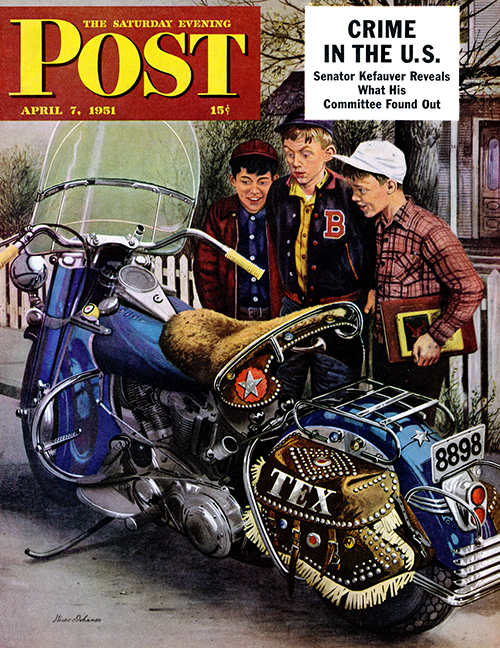
by Stevan Dohanos
From April 7, 1951
“When Stevan Dohanos said that he searched far and wide for a special type of motorcycle to paint,” wrote Post editors in 1951, “we got set for some fearfully technical details.” The artist’s specifications? “I just had to have a blue-and-silver one.” The object of pre-adolescent lust he found was owned by “Tex” Keeler of Georgetown, Connecticut (hence the name of the painting). Not surprisingly, motorcycle buffs love to buy reprints of this handsome cover.
“Wanted Posters”
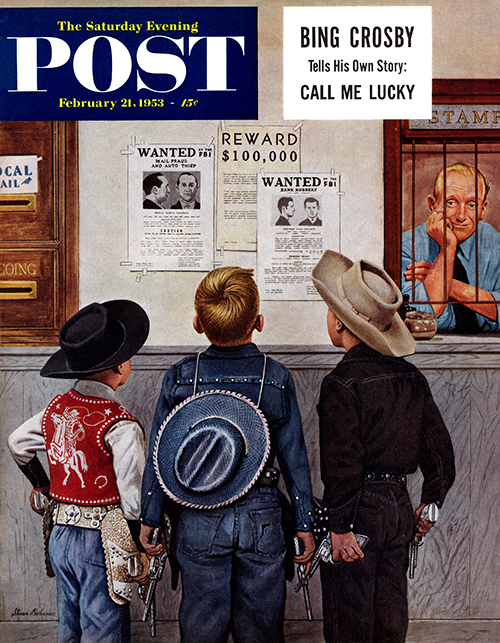
by Stevan Dohanos
From February 21, 1953
Three young cowboys, six-shooters at the ready, are looking at the wanted posters in the local post office. Never mind the amusement of the postal employee observing the scene—the bad guys don’t stand a chance. Dohanos didn’t have to go far to find the young male models. They were his sons.
Dohanos, who painted 123 Post covers, was born in Lorain, Ohio, the son of Hungarian immigrants.
“Playing House”
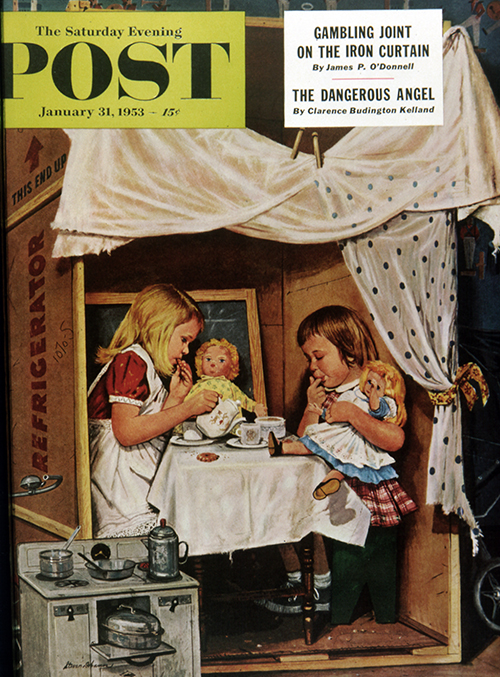
by Stevan Dohanos
From January 31, 1953
If you were a child of the female variety in the 1950s, one of your favorite playtime activities was probably playing house. This was what girls did before girls’ soccer and computers. The refrigerator carton is dressed up to make a perfectly lovely domicile, and every considerate hostess made sure the dollies got their share of tea and goodies. Do little girls still play house? I suppose there’s now an app for that.
“Doing Dishes at the Beach”
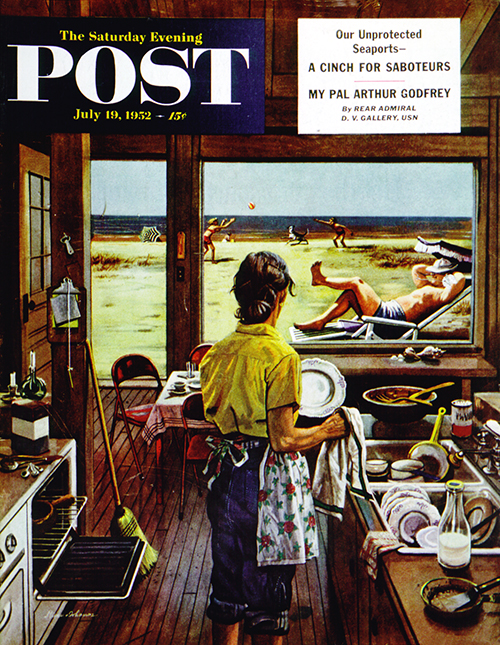
by Stevan Dohanos
From July 19, 1952
This is called “Doing Dishes at the Beach,” but I prefer to call it “Whose Vacation?” Clearly Dad is relaxing, and the kids are enjoying themselves. Heck, even Rover is having fun. Looks like Mom got short shrift. I have to love Dohanos for seeing male/female inequities even in 1952.
“Lighthouse Keeper”
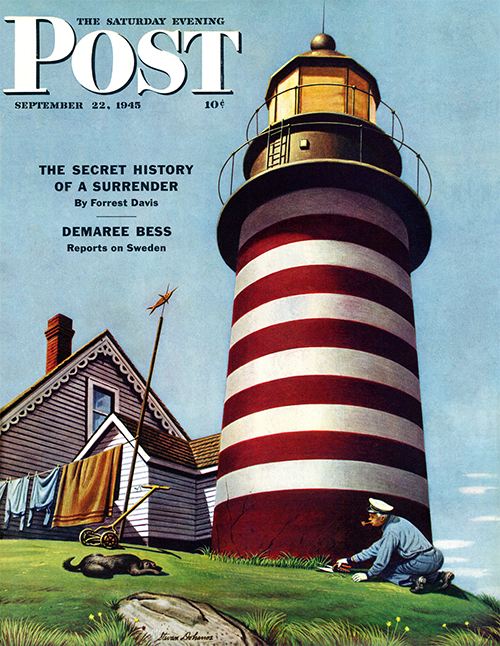
by Stevan Dohanos
From September 22, 1945
If a picture is worth a thousand words, this Dohanos cover tells a gentle story. The lighthouse keeper is trimming the weeds while the push lawnmower and the clothesline help define the times. The striking lighthouse on this 1945 cover was the West Quoddy Light, Lubec, Maine.
“Stop and Pay Toll”
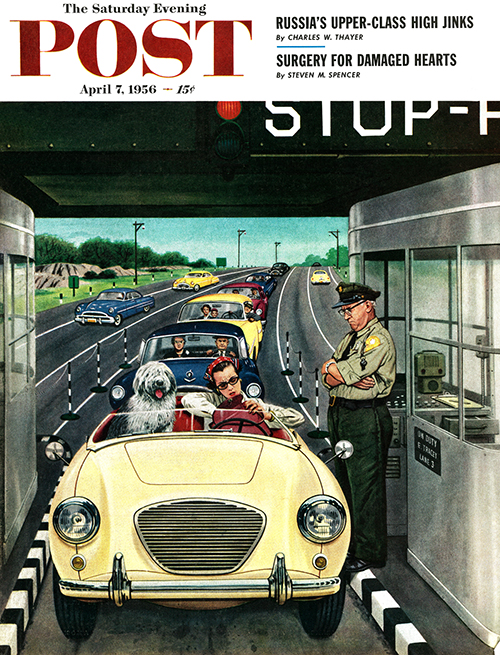
by Stevan Dohanos
From April 7, 1956
Life’s little stories include life’s little irritations. Admit it, your blood pressure is rising a bit just looking at the woman holding up the line at the tollbooth. There’s change in here, somewhere. Well, we hope. Heaven help the people behind her if she left her change purse at home. But if they have a problem with that, they can take it up with the extra-large dog.
Unfortunately, by the 1960s photographs were taking the place of art on the covers of the Post. Dohanos shifted his considerable talent to a position as chairman of the National Stamp Advisory Committee. He is quoted as saying, “Artists are always interested in seeing their work reproduced. Imagine seeing your work reproduced 4½ billion times.”
“Toddler Empties Purses”
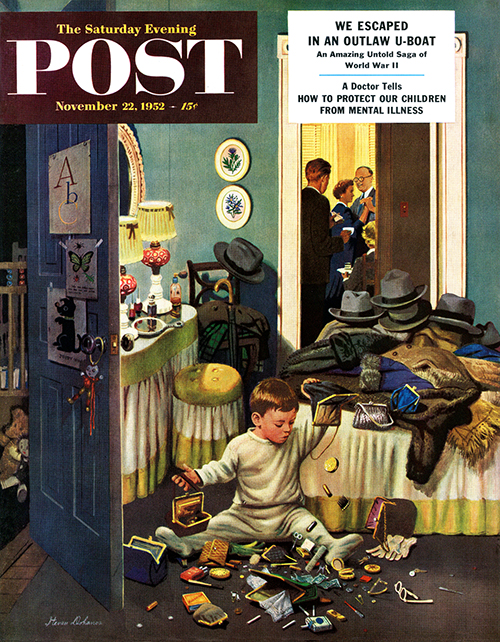
by Stevan Dohanos
From November 22, 1952
My favorite Dohanos cover has always been this toddler from 1952. Through the bedroom door, we can see the grown-ups having a pleasant get-together, but what they cannot see due to the stack of coats and fedoras on the bed is the toddler having his own rockin’ party. Unfortunately, he is having all this fun with the ladies’ purses, opening and scattering the contents: compacts, keys, cigarettes, sunglasses, money, and so on (click for close-up).
Questions on covers from The Saturday Evening Post? Email me at [email protected] or simply leave a comment below.
Classic Covers: A 1940s Summer
“Inn in Ogunquit” – John Falter
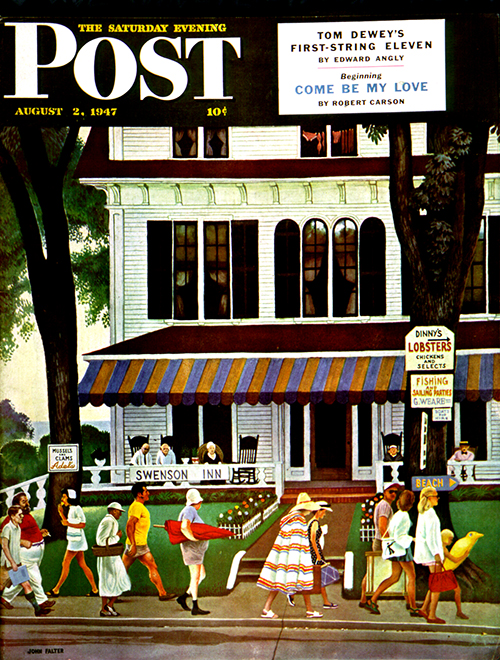
John Falter
August 2, 1947
Post cover artist John Falter spent many vacations at this inn in Ogunquit, Maine, and we are told he painted it very true to life. The older folks have prime seats in their porch rockers for watching the parade of characters heading to the beach.
“4-H Fair” – Stevan Dohanos
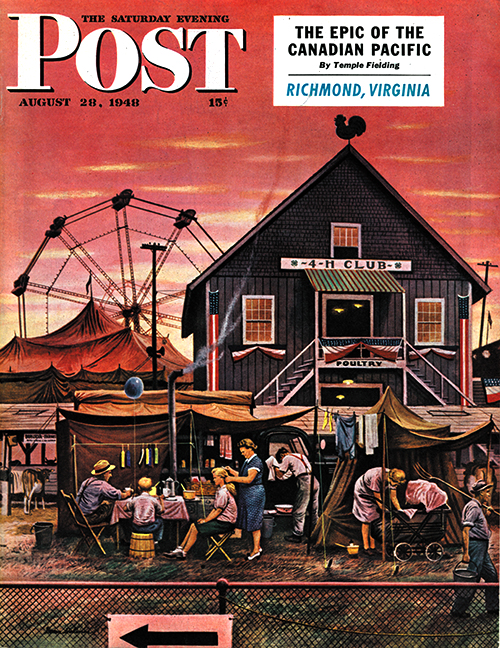
Stevan Dohanos
August 28, 1948
It wouldn’t be summer without the 4-H fair. This 1948 scene is also set in Maine, but by another great cover artist, Stevan Dohanos. The editors informed readers it was “the Skowhegan State Fair, a time-tested Maine recreation which claims to be the oldest fair in the land. Founded in 1819, the fair has been held every year since, without a break,” even in wartime. Here’s a pop quiz: What are the 4 “Hs”? (Answer at the end.)
“On Leave” – Norman Rockwell
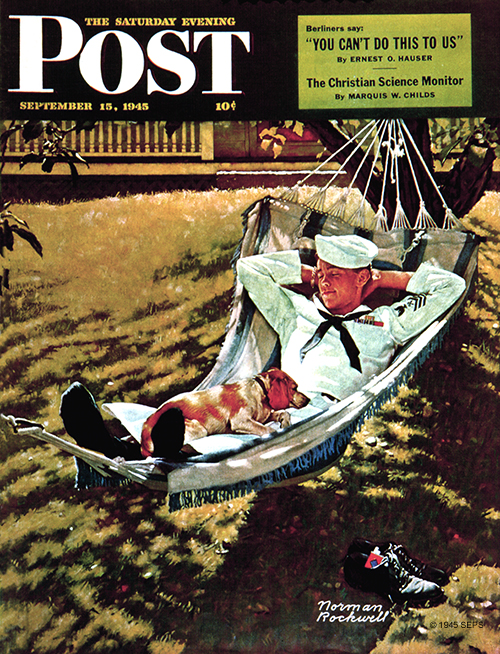
Norman Rockwell
September 15, 1945
This is my favorite summer cover. A lot of returning WWII soldiers were happily pulling hammock duty as in Rockwell’s 1945 cover. The artist borrowed the house from one neighbor, the hammock from another, and the dog from his son. An idyllic sun-dappled day of pure relaxation—and we wish many such blissful days for our troops returning today.
“Rainy Day at Beach Rental” – Stevan Dohanos
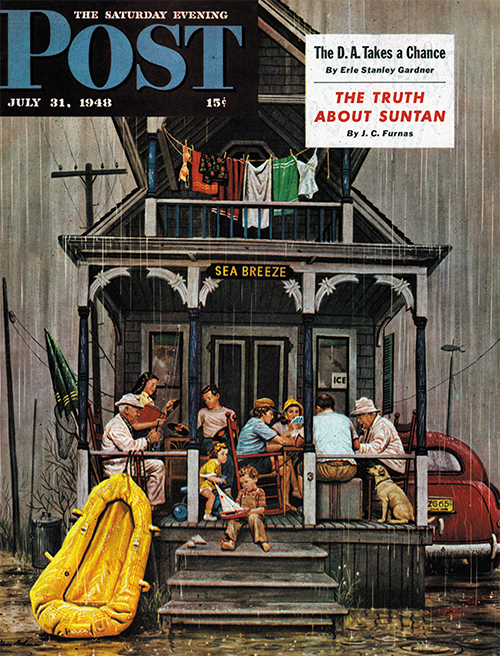
Stevan Dohanos
July 31, 1948
Alas, not every summer day is sun-dappled; some are rain-drenched. Artist Dohanos had his friends pose for him with the sun shining brightly in Martha’s Vineyard. He took the painting home to Connecticut, sure that the whole summer would be sunny and bright. But “I had a marvelous break,” he said. “It rained for three days straight. I could go out any hour of the day and get rain research.” One man’s nuisance is another man’s “rain research.”
“Tan Lines” – Albert W. Hampson
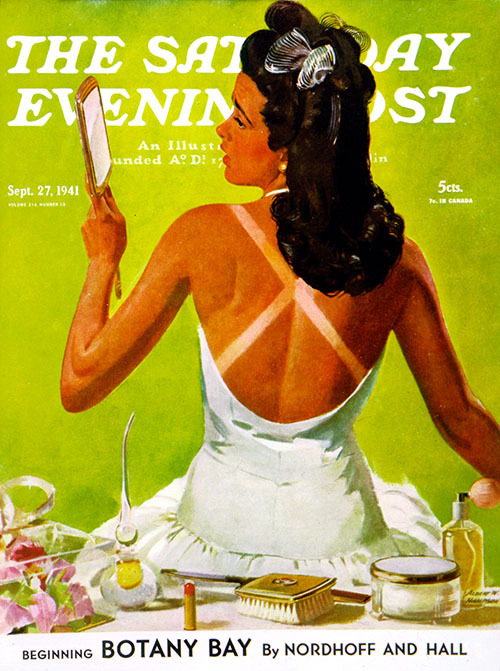
Albert W. Hampson
September 27, 1941
The pretty lady in this 1941 cover is learning a lesson relearned summer after summer. Tan lines and party dresses don’t mix. I love the pretty details on the vanity table.
“Housepainter and Bird’s Nest” – Stevan Dohanos

Stevan Dohanos
May 12, 1945
This is one of those situations where you’re an artist and you hire a guy to paint your house—and the guy ends up posing for you as a house painter. You know, one of those situations. The idea of the bird’s nest was the artist’s, but the house painter confirmed he had run into the situation many times. The painter (house painter, not the cover painter) said he always tried to give the birds as much leeway as possible, carefully returning the nest to it’s proper spot. The artist, Stevan Dohanos, noted: “I found out that the overalls he was wearing had just escaped being washed the day before. That would have been tragic, because it would have made them spotless and taken away that typical bag in the seat.” Well, what do you expect from a guy who does “rain research”?
Oh, yes, the four “Hs” in the 4-H Pledge are: “I pledge my head to clearer thinking, my heart to greater loyalty, my hands to larger service, and my health to better living, for my club, my community, my country and my world.”
Classic Covers: The Art of the Haircut
“Woman Gets Bob at Barbershop” – E.M. Jackson
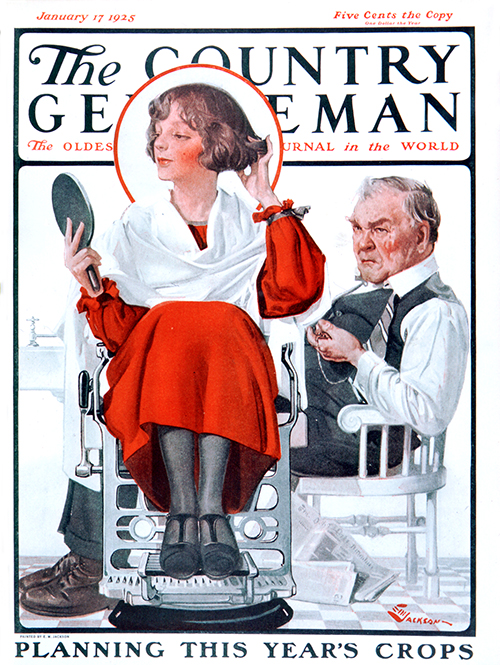
E.M. Jackson
Country Gentleman January 17, 1925
Females these days think they can waltz into a man’s territory and get their hair bobbed! What next? In this case the cover is from Country Gentleman (a sister publication to the Post) from 1925. Waiting impatiently (notice the pocket watch) is a disapproving customer.
“Couple in Barber Chairs” – E.M. Jackson
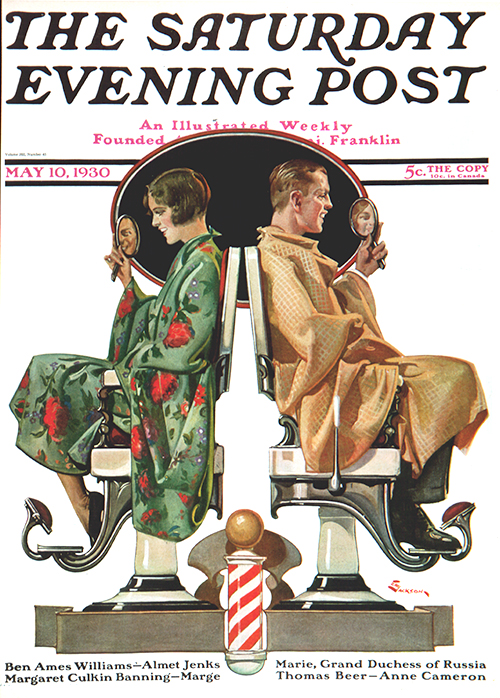
E.M. Jackson
May 10, 1930
The same artist, E.M. Jackson, did this charming cover for the Post five years later. Seems as though they’re examining their new dos, but look at their mirrors. They’re checking each other out!
“Bernice Bobs Her Hair” – Coles Phillips
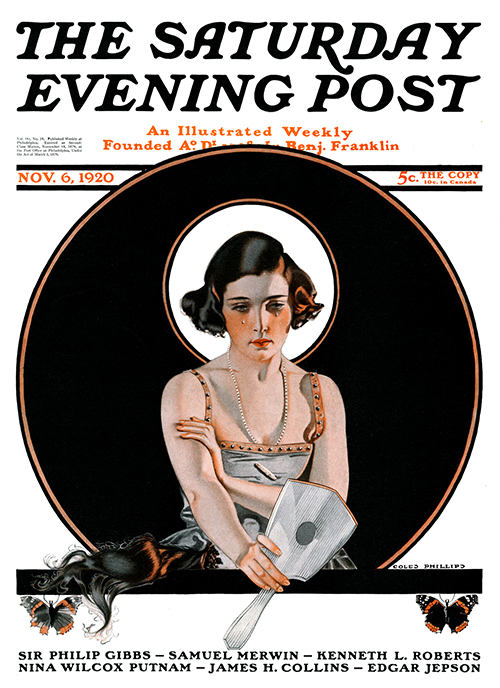
Coles Phillips
November 6, 1920
Alas, this lovely lass is having haircut remorse. Artist Coles Phillips worked mostly for Life magazine, but a few of his lithe beauties graced the covers of The Saturday Evening Post.
“Comical Haircut” – Howard Scott
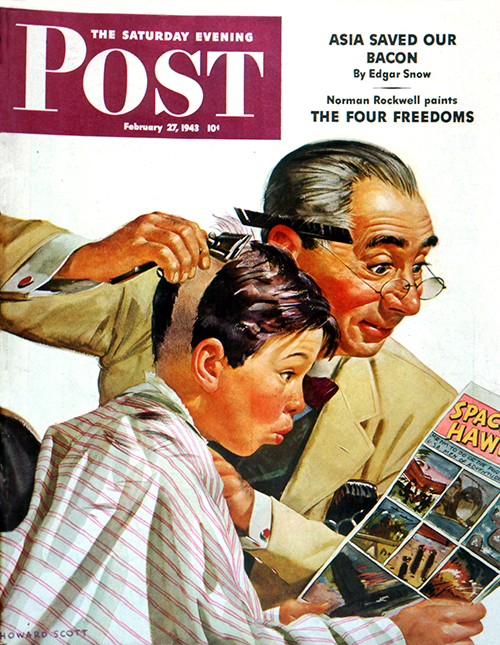
Howard Scott
February 27, 1943
Talk about haircut remorse! Really, the client can get carried away with comics, but the barber is another matter altogether. The style and humor of this 1943 cover suggests Norman Rockwell, but it was by an artist named Howard Scott. However, this was the issue that introduced Rockwell’s famous Four Freedoms paintings.
“Barber Getting Haircut” – Stevan Dohanos
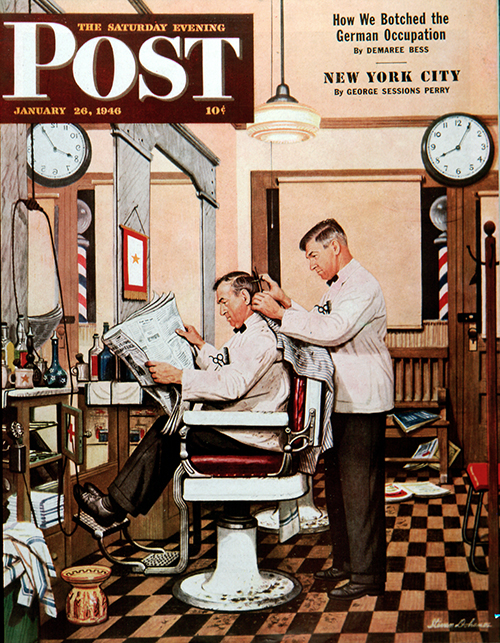
Stevan Dohanos
January 26, 1946
Stevan Dohanos was a great artist who did over 120 Post covers, and this was his barbershop in Westport, Connecticut. “A half dozen other well-known illustrators get their hair cut” in this shop, the editors noted, “which will surprise a good many, who might suppose that a barber in an artist’s colony would starve to death.” How would the local barbers like the cover, speculated our sassy editors? “Dohanos’ next haircut will tell.”
Questions and comments about Saturday Evening Post covers are always welcome.
Classic Covers: Football is Rough on Everyone!
Are you ready for some football? Since 1900, The Saturday Evening Post has featured football and football fans on its covers, so grab a cold one and some chips and enjoy!
Rainy Football Game by Douglas Crockwell
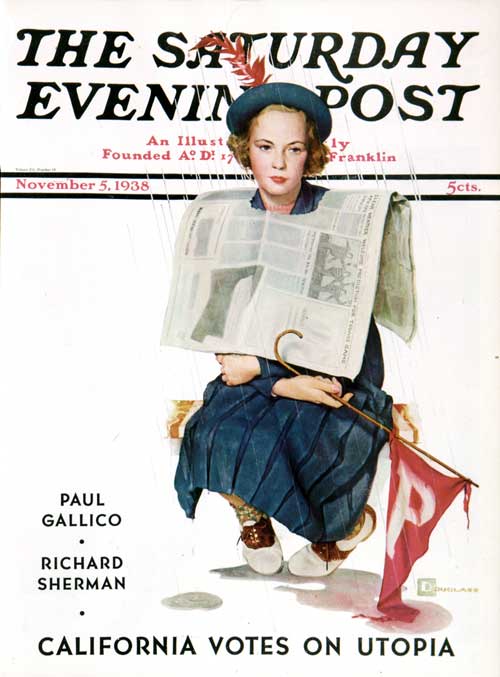
Douglas Crockwell
November 15, 1941
Are you ready for some football? Since 1900, The Saturday Evening Post has featured football and football fans on its covers, so grab a cold one and some chips and enjoy!
Quarterback Pass by Maurice Bower
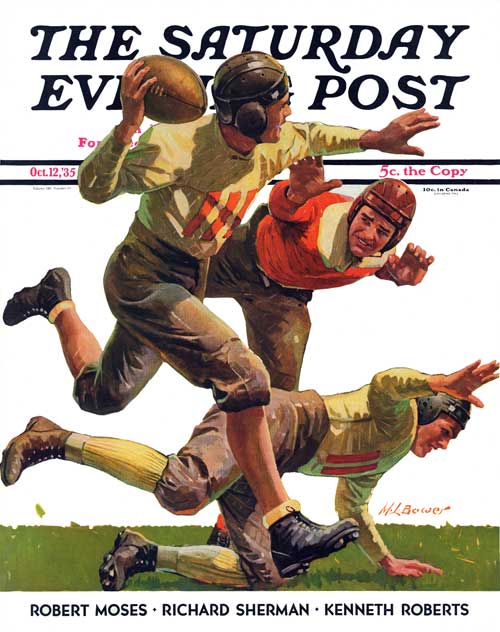
Maurice Bower
October 12, 1935
Maurice Bower (1889-1980) was an artist who could capture action: racing horses, men jumping hurdles and, of course, a quarterback making a pass. He was a medical illustrator for the army in World War I. He did fourteen covers for the Post, and this one from 1935 takes you right to the heart of the action. Love the strain on the guy’s face.
Tackled by Norman Rockwell
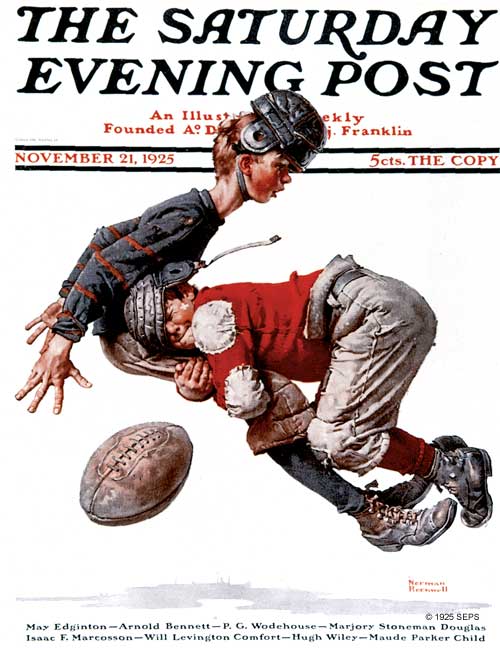
Norman Rockwell
November 21, 1925
Omphf! Norman Rockwell shows just what a rough sport this can be. After this hard tackle in 1925, somebody is going to have a sore belly…if not a cracked rib or two. And this is just a kids’ game.
Dog on the Field by Lonie Bee
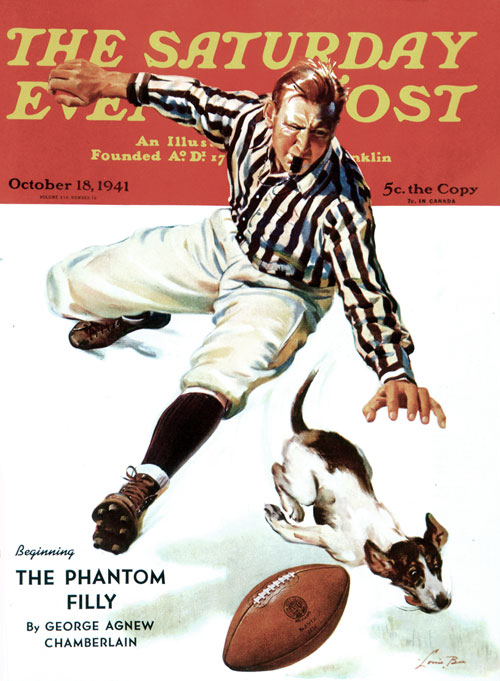
Lonie Bee
October 18, 1941
Players aren’t the only ones who have a rough time of it. The ref has a hard job too, especially when Spot decides he’s in to play. This cover by artist Lonie Bee is from 1941.
Ref Out Cold by Stevan Dohanos
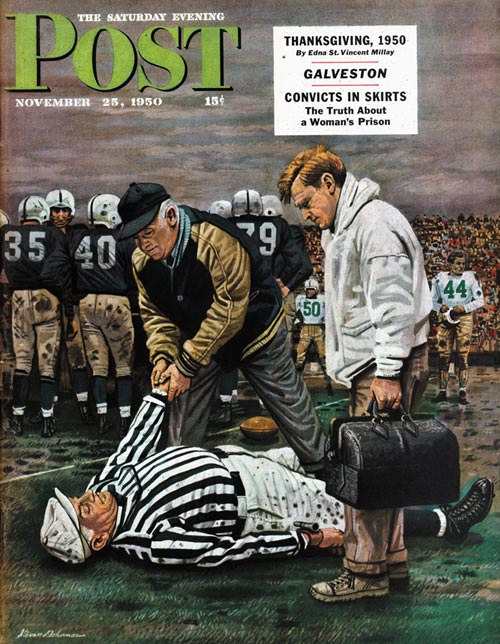
Stevan Dohanos
November 25, 1950
Talk about a tough job! Artist Stevan Dohanos “witnessed this catastrophe at a Yale-Dartmouth conflict last year,” wrote the Post editors in 1950. “Everybody but the wounded man was amused, and Dohanos reflected callously, Ah a delightful cover scene!” The poor ref in real life was Leo Weinrott who “suffered disengaged leg muscles when a young giant accidentally steam-rollered over him. He tottered on about his terrifying duties until, stubbing a cleat while running backward, he had to be removed from the battlefield on a litter.” Fortunately, there’s a happy ending: “This fall,” noted the editors, “he survived the Yale-Cornell and other Donnybrooks with hardly a contusion. He thinks the cover is droll.”
Cheerleaders After a Losing Game by Lonie Bee
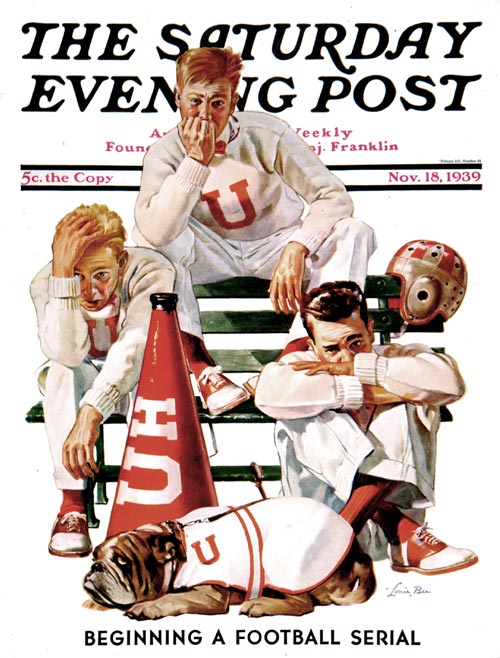
Lonie Bee
November 18, 1939
And don’t think being a cheerleader is all fun and games, either. When you cheer your heart out and the team loses, it’s a sad day. These cheerleaders (all male!) from a 1939 cover are completely bummed. Even the adorable mascot is down and out.
Sitting on the Wrong Side by Gene Pelham
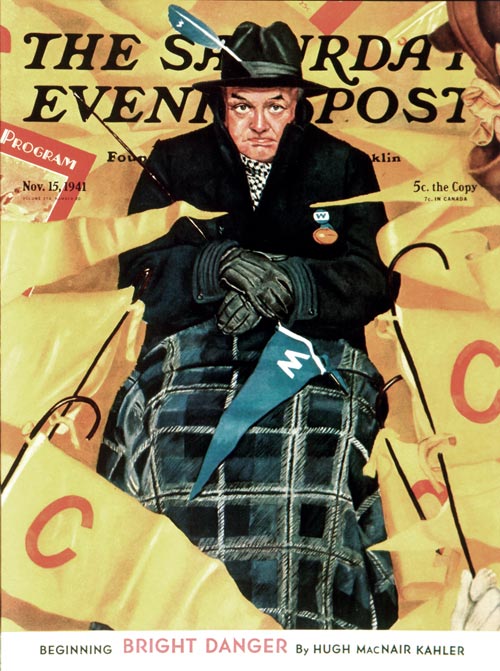
Gene Pelham
November 15, 1941
We would never forget you, the great American football fan. How you have suffered! You bundle up against the cold, tough it out and root for your team and your little blue pennant is being overwhelmed by the sea of yellow pennants belonging to the winning team. Great facial expression by little known artist Gene Pelham. It says it all. There’s always the next game!
Classic Covers: Dogs Hate School!
If there’s anything we’ve learned from studying hundreds of magazine covers for the Post and The Country Gentleman, a sister publication, it is that dogs hate school! If you’re bummed about returning to school, you’re not the only one.
Robert C Kauffmann
September 10, 1938[/caption]
This Robert C. Kauffmann painting is one of our favorite dog covers — and we have decades and decades of dog covers. How long that sweet mutt is going to stare at the door, nobody knows, but best friends are loyal.
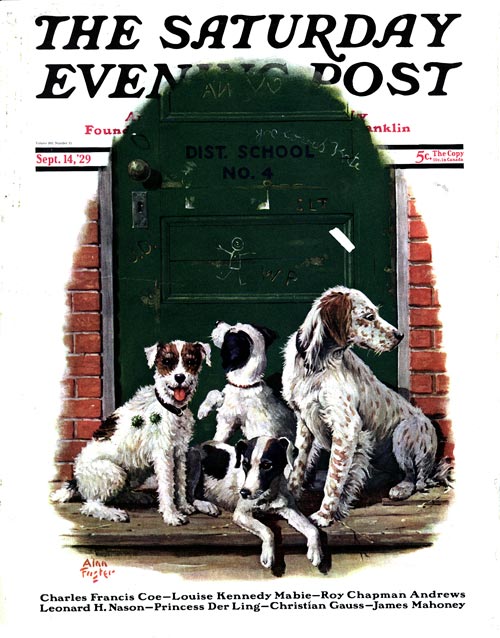
Alan Foster
September 14, 1929
These pups have been at it longer; they’re at least sitting down and waiting. If they’re teaching something useful like fishing or stick-throwing in there, these loyal friends might understand, but what’s taking so long? This is one of 30 covers Alan Foster painted between 1923 and 1933 for the Post.
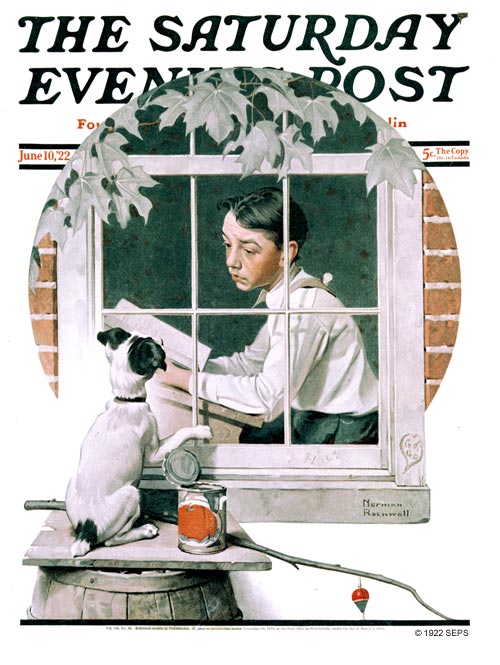
Norman Rockwell
June 10, 1922
Humorous every-day scenes like the one above were popular in the 1920s. The cover of was one of 10 Saturday Evening Post covers Rockwell did in 1922, along with two Country Gentleman covers and other ad work and art assignments. We’ve often wondered when the man slept.
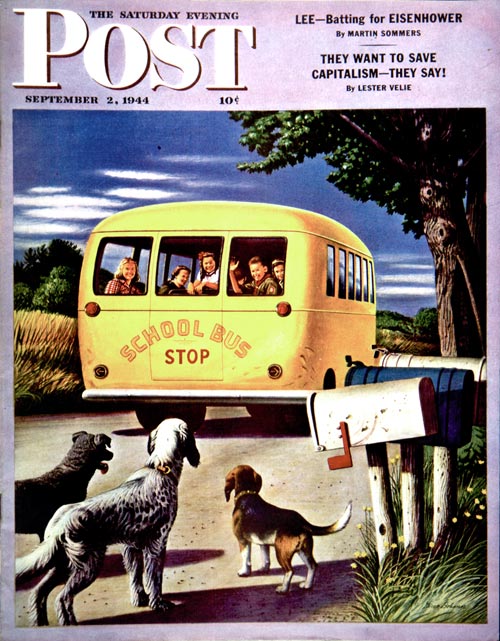
Stevan Dohanos
September 2, 1944
“Dear Editor: I know this may be a stretch, but I have a special request. I am looking for an issue of your magazine from September 2, 1944. It is special to me because I am the Boy Scout in the painting by Stevan Dohanos. His son was a pal of mine and, in the 6th grade, I was asked to pose in my scout uniform. I think I got paid $10! Plus I spent the night at his house and had a great time. I can still remember the shoot.” This email from a couple of years ago was signed George. We’re glad George enjoyed the shoot, because the dogs are clearly not enjoying having their pals carted away in that big yellow thing.
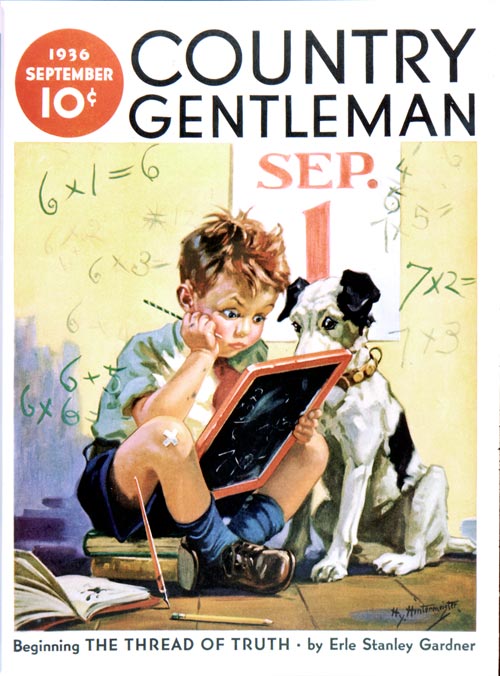
Henry Hintermeister
The Country Gentleman
September 1, 1936
If there’s one thing dogs hate more than school, it’s homework — or at least math homework. If nothing else, Rover can provide moral support. The artist, Henry Hintermeister, certainly wasn’t a household name, but he did at least 16 Country Gentleman covers, all terrific ones, of kids.
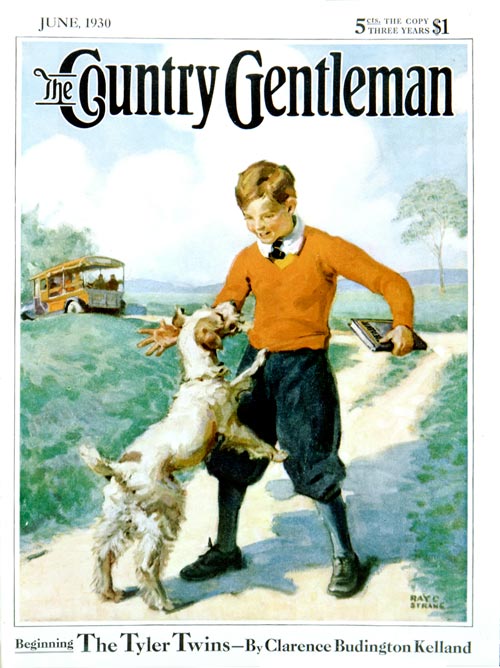
Ray C. Strang
The Country Gentleman
June 1, 1930
If there’s one thing about school dogs love, it’s when Billy gets off that bus! We should all have a welcoming committee like this one. Love the pastels in this painting. And dig that 1930 school bus in the background.
Classic Covers: “Covering America” Art Show
The Post is proudly showing off paintings it made famous in your parents’ living rooms each week. The “Covering America” Art Show will be in Lafayette, Indiana (at the Art Museum of Greater Lafayette) from May 21 – September 11, 2010, with plans in the works for future exhibitions. From stunning landscapes to rousing brass bands, from churches to baseball fields, The Saturday Evening Post cover artists presented America during the 1950s and 1960s like no other medium. Come take a peek!
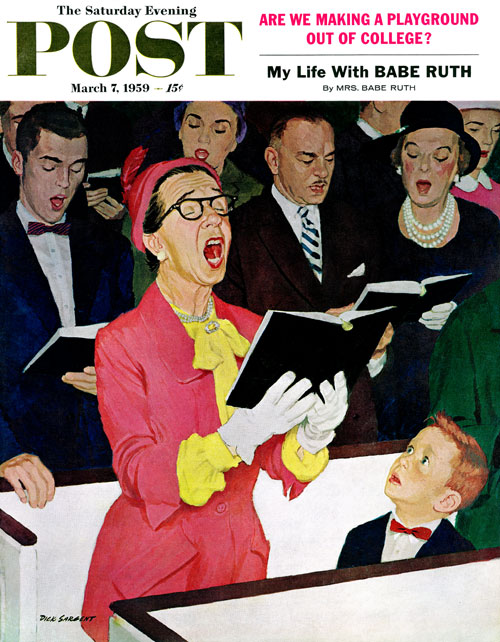
Singing Praise
Dick Sargent – March 7, 1959
“Never before has that little boy heard anything like Mrs. Bellows,” the editors said of this painting. Typical of artist Dick Sargent’s delightful humor, “Singing Praise” was a cover in March 1959. We don’t have to tell you the boy’s face is priceless (but we’ll say it anyway).
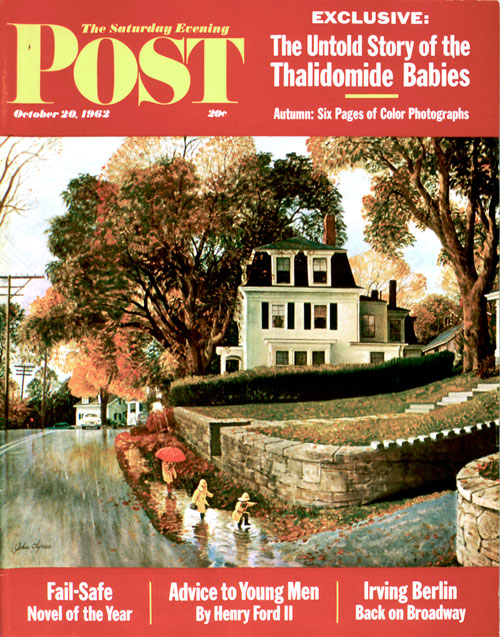
Walking Home in the Rain
John Clymer – October 20, 1962
The exhibit features several John Clymer covers, and this one from 1962 combines the artist’s talent for painting nature with a charming scene of children walking home in a chill autumn rain. The artist came across the scene in Rockport, Massachusetts while traveling and “looking for Americana”. “If there is a puddle to be found,” the artist noted, “kids will find it and walk in it.” Well, gee, isn’t that what boots are for?
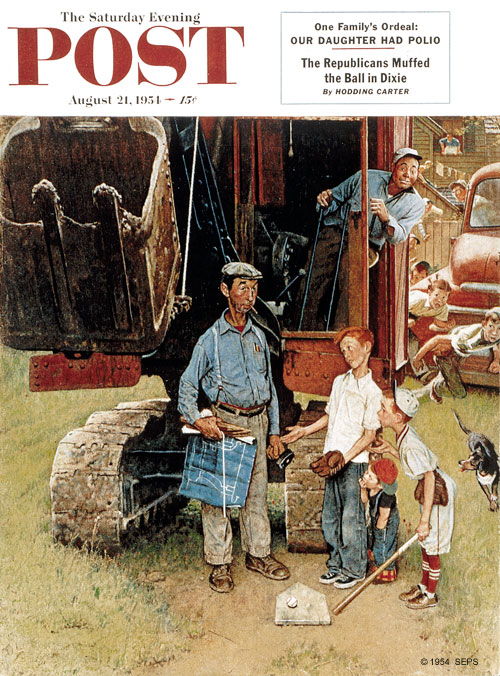
Construction Crew
Norman Rockwell – August 21, 1954
This is progress? Home plate is giving way to the bulldozer for a new house. Always one for authenticity, Norman Rockwell found the boys by knocking on doors in Stockbridge and asking for members of the Little League team. Some were used as models in later covers. Is the tiny boy sucking his fingers too cute or what?
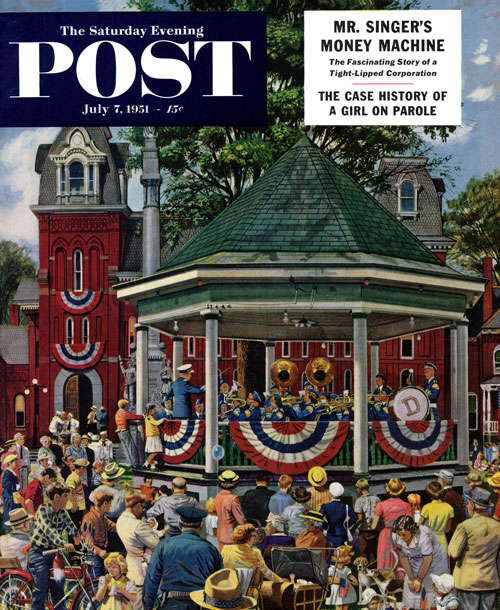
Patriotic Band Concert
Stevan Dohanos – July 7, 1951
Stevan Dohanos did over 120 memorable Post covers, and readers loved this one from 1951. There is a lot going on at this Fourth of July concert in Delhi, New York. Grandparents listening, dogs and kids checking things out, sailors chatting, and tiny tots are having meltdowns. The editors noted, “When Dohanos set up his easel opposite Town Hall, passers-by forgathered to see why, and the first thing they knew, the were on canvas.”
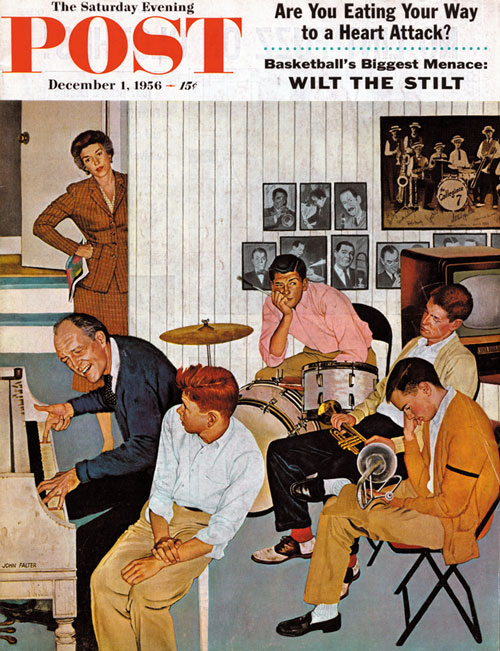
Jamming with Dad
John Falter – December 1, 1956
Dad crashes junior’s jam session and the guys are, well, less than enthused. Artist John Falter also did well over 100 Saturday Evening Post covers, and life with kids was a favorite topic. Note the college band photo on the wall – straw boaters and all. The photo montage of jazz greats gives us a clue to the type of music dad finds cool, and the kids…well, let’s just say they don’t dig all that jazz.
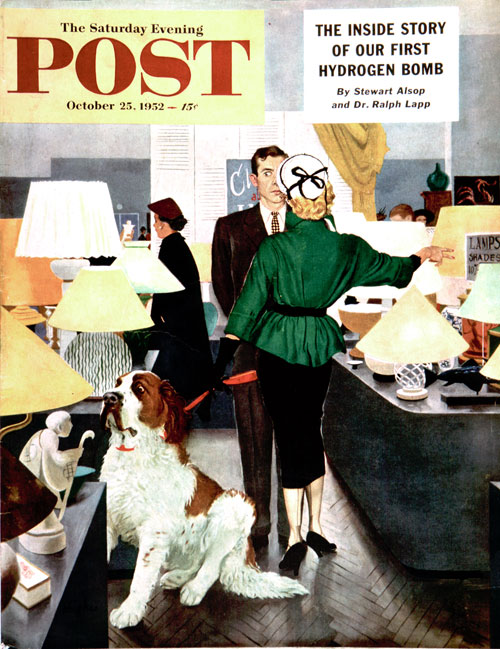
St. Bernard in Lamp Shop
George Hughes – October 25, 1952
Another frequent Post cover artist, George Hughes, clearly sympathizes with the nervous clerk in this painting from 1952. Editors noted, “it can be said in this lady’s favor that she would not take a bull into a china shop.” One swipe of Bernie’s tail would probably make the point moot.
Classic Covers: Special Delivery!
Delivery truck, bus stop, or even boat, Post covers have shown us how to get our holiday shopping home. Sometimes with difficulty.
One hundred years ago this very month, scurrying home with his purchases is the gentleman in J.C. Leyendecker’s December 4, 1909 cover. How he manages to carry even a rocking horse at such a rapid clip is one of the mysteries of the season.
Another rocking horse shows up on artist James R. Bingham’s inviting 1945 cover. It is a rather clumsily wrapped gift—but how does one wrap a horse? As the editors noted, “Santa himself could not make a rocking horse look like anything else.”
A rural post office on artist Stevan Dohanos’ December 1947 cover is about to get some business from the man bearing parcels while the dog and the cow wait in the truck. (We’re told the cow was one of the most cooperative models the artist had in a long time.)
Waiting for a bus laden with purchases is a hard way to get gifts where they need to go! Dohanos’ 1952 cover shows a crowd waiting, some rather impatiently, for that ride. Too bad we can’t see the next scene, where the man jiggles the sled through the bus door, and the older lady surprises the bus driver by hauling a tree aboard. And … is that a goose?
Our most unusual Christmas delivery must be on Mead Schaeffer’s December 1946 cover. Rowing the gift-laden boat to the lighthouse in the chill winter must be a challenge. The picturesque lighthouse existed in real life (and still does) in the Hudson River between Athens and Hudson. A man named Edward Bremmer tended the light and is shown rowing the boat. The editors suggested he might be startled when he gets to the lighthouse. In depicting the Bremmer family, the artist decided to add three additional children. Surprise!
To order your favorite holiday cover and browse the entire collection, visit saturdayeveningpostcovers.com.
Stevan Dohanos
December 13, 1952
J. C. Leyendecker
December 4, 1909
James R. Bingham
December 22, 1945
Steven Dohanos
December 13, 1947
Mead Schaeffer
December 28, 1946
Classic Covers: Keeping Up with Yard Work
“Gardening requires lots of water — most of it in the form of perspiration,” said author Lou Erickson, and our Post covers prove it. Some people are downright persnickety in the care of their lawns and gardens while others are content to let Mother Nature take her course.
Definitely the odd couple. Mr. Felix is fastidious to the point where we believe the blades of grass salute as he walks by. Note how even the flowers stand at attention. But he isn’t all uptight: He is, after all, keeping up with the baseball game on his handy black and white TV while working. But in the July, 1961 cover by artist John Falter, Mr. Oscar next door is taking it easy, not at all bothered by overgrown hedges and toys on the sidewalk. Well, he probably had a hard week at work. Obviously, his dog did, too.
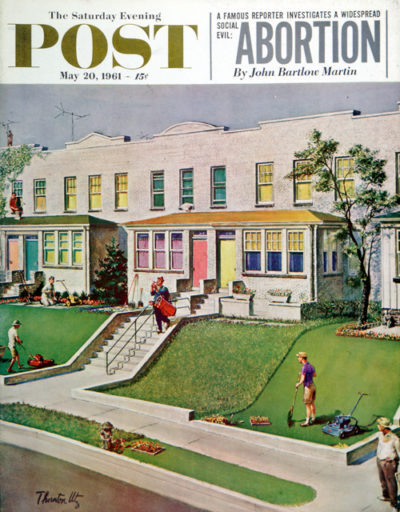
I'd Rather Be Golfing
May 20, 1961
On the other side of town, two equally fastidious neighbors are flummoxed—yes, that’s the word, flummoxed. In the May 20, 1961, cover by Thornton Utz, the lawn slaves work with push mowers and rakes while the guy from number 319 spends his Saturday as he darn well pleases, which includes lighting up a big cigar and taking his golf clubs for a walk, with nary a backward glance at his overgrown lawn.
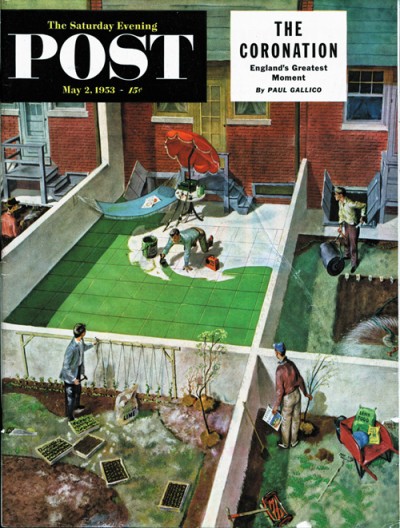
Painting the Padio Green
May 2, 1953
There’s more than one way to green up a lawn. In Utz’s May 2, 1953, cover, one man simply laid concrete and painted it green—and flummoxed neighbors appear once again. As the 1953 Post editors observed, “What sound-minded man would rest in a hammock when he can sprain his muscles spading the sweet earth?” Sound-minded or not, we have to give the guy points for ingenuity.
It isn’t only private lawns that need tending. Stevan Dohanos’ 1945 lighthouse, bold in red and white stripes, includes a busy groundskeeper neatly trimming the weeds, with no help whatsoever from the lazy pooch nearby.
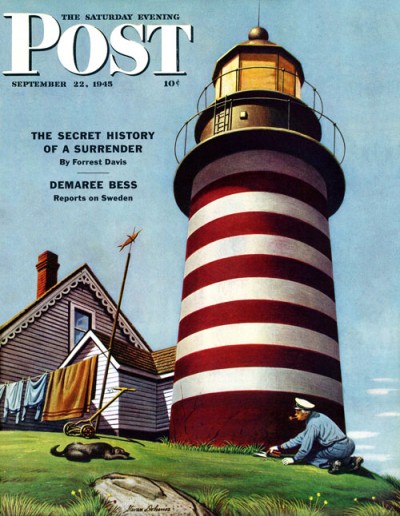
Lighthouse Keeper
9/22/1945
Fond of finding gardens in unusual spots, Dohanos also painted the August 9, 1947, cover depicting three railroad workers watering a flower bed with the train looming right behind them—a cover to please both gardeners and train buffs alike.
Possibly the oddest spot for a garden was found by artist John Atherton. In a junkyard in Pittsburgh, no less, amid heaps of rusty scrap iron, the derrick operator planted a small garden. The enterprising man even made a fence around his plot using strips of scrap iron. “Gardens are a form of autobiography,” said Sydney Eddison, highly acclaimed gardening author and teacher, so it says much about the man that he seeks beauty amid the unsightly.
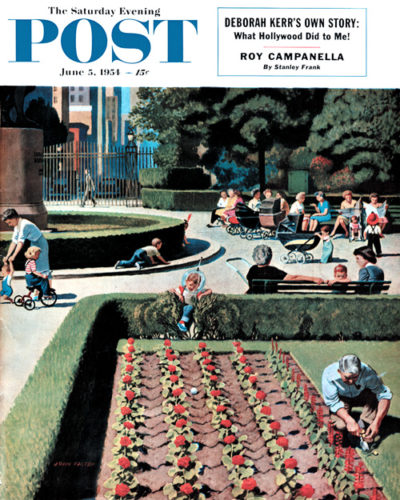
City Park
June 5, 1954
In Falter’s June 5, 1954, cover, as a man tends a downtown plot of flowers, his territory seems to be invaded by a spaceman after his baseball. Okay, some covers are just hard to explain—you’ll have to click on it and see for yourself. The older couple in Stevan Dohanos’ May 26, 1951, cover do the watering. Well, at least he is, and we must say that’s a lot of garden to water with a hose. When Post editors asked Dohanos, “What ate some of the lettuce and radishes in your picture—rabbits?” the artist replied, “Certainly not. People. No pests in my gardens. They don’t like the smell of paint.” Well, we warned you that artists are an odd lot.
Gallery
Lighthouse Keeper
9/22/1945
Tidy and Sloppy Neighbors
July 1, 1961
I’d Rather Be Golfing
May 20, 1961
Painting the Padio Green
May 2, 1953
Lemonade for the Lawnboy
May 14, 1955
City Park
June 5, 1954
Trainyard Flower Garden
August 9, 1947
Spring Yardwork
May 18, 1957
Cover Collection: The Art of Work
“A man is a worker. If he is not that, he is nothing.” – Joseph Conrad
Work! Some people claim to love it. Others vow they hate it. Some are notably better acquainted with it than others, but we won’t name names.
“What work I have done, I have done because it has been play. If it had been work, I shouldn’t have done it,” Mark Twain said.
Thomas Edison observed, “As a cure for worrying, work is better than whiskey.”
The British humorist, Jerome K. Jerome, summed up many peoples’ view on the subject: “I like work. It fascinates me. I can sit and look at it for hours.”
Which brings us to our famous cover artists. From a place of relative safety behind their easels, unfettered by nine-to-five jobs and the usual drudgery (except when their wives pulled them away to put up storm windows), they were free to sit back and observe the American “workscape” in all its glory, from window washers and sign painters to plumbers and construction workers.
They even turned a lady riveter into the most famous cover girl of all.
In keeping with the theme of this issue, we put our own shoulders to the task and created this tribute to the art of work. Now we’re going to take a break while you sit back and enjoy it.
